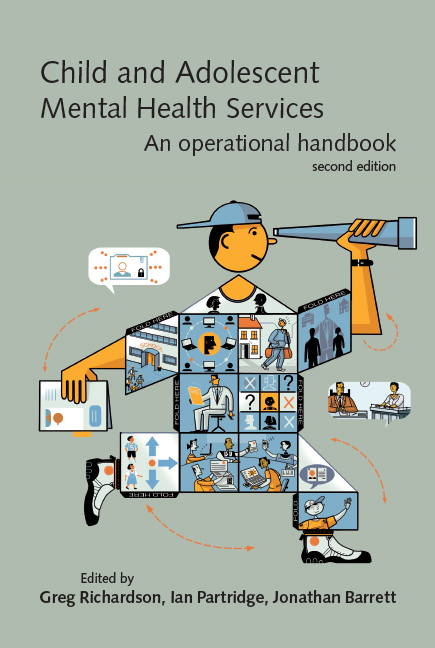Book contents
- Frontmatter
- Contents
- Tables, boxes and figures
- Contributors
- Abbreviations
- Preface
- 1 Introduction
- 2 CAMHS in context
- 3 CAMHS and the law
- 4 Structure, organisation and management of CAMHS
- 5 Evidence-based practice
- 6 Clinical governance
- 7 Education, supervision and workforce development
- 8 Multidisciplinary working
- 9 User and carer participation and advocacy
- 10 A comprehensive CAMHS
- 11 Referral management
- 12 Demand and capacity management
- 13 Strategies for working with Tier 1
- 14 Structuring and managing treatment options
- 15 CAMHS in the emergency department
- 16 Paediatric liaison
- 17 Self-harm
- 18 Learning disability services
- 19 Services for autism-spectrum disorders
- 20 Attentional problems services
- 21 Eating disorder teams
- 22 Bereavement services
- 23 CAMHS for refugees and recent immigrants
- 24 CAMHS and looked-after children
- 25 Drug and alcohol teams
- 26 Parenting risk assessment service
- 27 Court work
- 28 Tier 4 options
- 29 In-patient psychiatric care
- 30 Forensic services
- 31 Neuropsychiatry and neuropsychology services
- 32 Mental health provision for deaf children: study of a low-incidence service provision
- 33 Chief Executives – what do they want and how do they get it?
- Index
2 - CAMHS in context
- Frontmatter
- Contents
- Tables, boxes and figures
- Contributors
- Abbreviations
- Preface
- 1 Introduction
- 2 CAMHS in context
- 3 CAMHS and the law
- 4 Structure, organisation and management of CAMHS
- 5 Evidence-based practice
- 6 Clinical governance
- 7 Education, supervision and workforce development
- 8 Multidisciplinary working
- 9 User and carer participation and advocacy
- 10 A comprehensive CAMHS
- 11 Referral management
- 12 Demand and capacity management
- 13 Strategies for working with Tier 1
- 14 Structuring and managing treatment options
- 15 CAMHS in the emergency department
- 16 Paediatric liaison
- 17 Self-harm
- 18 Learning disability services
- 19 Services for autism-spectrum disorders
- 20 Attentional problems services
- 21 Eating disorder teams
- 22 Bereavement services
- 23 CAMHS for refugees and recent immigrants
- 24 CAMHS and looked-after children
- 25 Drug and alcohol teams
- 26 Parenting risk assessment service
- 27 Court work
- 28 Tier 4 options
- 29 In-patient psychiatric care
- 30 Forensic services
- 31 Neuropsychiatry and neuropsychology services
- 32 Mental health provision for deaf children: study of a low-incidence service provision
- 33 Chief Executives – what do they want and how do they get it?
- Index
Summary
‘The farther backward you can look, the farther forward you are likely to see.’
Winston Churchill (1874–1965)Introduction
Over the years, CAMHS have had disparate masters and homes. Local Authority-based child guidance clinics and health service-based in-patient units came together in 1974. At that time, there was recognition that mental health services for children and adolescents should be based in the community rather than in institutions (Department of Health and Social Security, 1975). Now that they are based in health services, the idea and functioning of multidisciplinary services and teams can represent a mystery to doctor-led, referral-based health systems and those responsible for commissioning such services. Child and adolescent mental health services have often been prey to strategic and resource neglect, but idiosyncratic clinical practice has often been of an outstanding nature. With the acceptance of a tiered strategy for CAMHS, there has been increased coordination, an influx of resources and increased scrutiny (Department for Children, Schools and Families & Department of Health, 2008).
Publications in the field of social care (e.g. Children in the Public Care; Department of Health & Social Services Inspectorate, 1991), a precursor of Quality Protects (Department of Health, 1999), education (e.g. Getting in on the Act; Audit Commission, 1992) and health (e.g. With Health in Mind; Kurtz, 1992) were calling attention to children ‘in need’, children with ‘educational and behavioural difficulties’ and children with ‘mental health problems’. They overlapped considerably. Traditionally, health services were interested only if a child had a mental health problem, Social Services were interested only in children in need, and education services were interested only in children with emotional and behavioural difficulties, but children's developmental needs cannot be subdivided into different educational, social and health boxes without a similar dismembering of the child.
It was only in the early 1990s that the need to work across agencies achieved some political recognition as ‘care in the community’ was failing for lack of it. In 1993, as part of the Health of the Nation initiative, Working Together for Better Health (Department of Health, 1993) showed government recognition of health being dependent on ‘healthy alliances’ across agencies. To those using formulations that looked at the constitutional, family and environmental factors affecting children at their developmental stage this was nothing new, but it was quite a shift for medically based illness services.
- Type
- Chapter
- Information
- Child and Adolescent Mental Health ServicesAn Operational Handbook, pp. 9 - 20Publisher: Royal College of PsychiatristsFirst published in: 2017



